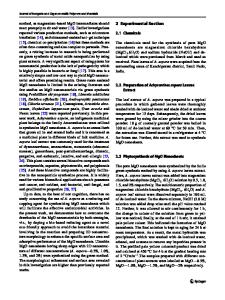N-doped two-dimensional ultrathin NiO nanosheets for electrochromic supercapacitor
- PDF / 1,971,822 Bytes
- 9 Pages / 595.276 x 790.866 pts Page_size
- 63 Downloads / 292 Views
N-doped two-dimensional ultrathin NiO nanosheets for electrochromic supercapacitor Junying Xue1, Shen Wang1, Hongming Zhang1, Ying Song1,*, Yao Li2,* Jiupeng Zhao1,* 1 2
, and
School of Chemistry and Chemical Engineering, Harbin Institute of Technology, Harbin 150001, People’s Republic of China Center for Composite Materials and Structure, Harbin Institute of Technology, Harbin 150001, People’s Republic of China
Received: 26 July 2020
ABSTRACT
Accepted: 30 September 2020
The performance of electrochromic supercapacitors (ESCs) can be improved by the use of electrodes with high electronic conductivity and ion transport ability. Herein, two-dimensional (2D) N-doped NiO ultrathin nanosheets (N-NiO UTNSs) synthesized in situ on fluorine-doped tin oxide glass were used as bifunctional ESC electrodes. These electrodes exhibited an elevated specific capacitance (540 F g-1 at 1 A g-1), superior cycling stability (85% capacitance retention after 10,000 cycles), and good electrochromic properties (color change from colorless to black with a transmittance modulation of 73% and a coloration efficiency of up to 83.47 cm2 C-1 at 550 nm), which was ascribed to the high electronic conductivity of NiO (due to N doping) and the short ion diffusion path (due to the ultralow nanosheet thickness). To further explore the practical applications of N-NiO UTNSs, we constructed asymmetric ESCs by integrating NiO films with Fe2O3 films and revealed that these devices displayed applied voltage–dependent colors. Two charged asymmetric ESCs connected in series could light up a red light-emitting diode and changed color synchronously with charge state alteration. Thus, our results contribute to the development of Nibased electrochromic supercapacitors exhibiting charge state-dependent color changes.
Ó
Springer Science+Business
Media, LLC, part of Springer Nature 2020
1 Introduction Electrochromism is a phenomenon which the color of a material changed reversibility simultaneous insertion/extraction of ions. With the advent of electronic device intellectualization, much effort has been directed at the realization of novel personalized
electrochromic supercapacitors in line with the general trend observed in the field of science and technology [1]. The working mechanism and structure of supercapacitors are similar to those of electrochromic indicators, which allows the fabrication of bifunctional electrochromic supercapacitors (ESCs) exhibiting visually discernible (dis)charge state-dependent color changes [2–4]. In this context, inorganic
Address correspondence to E-mail: [email protected]; [email protected]; [email protected]
https://doi.org/10.1007/s10854-020-04581-3
J Mater Sci: Mater Electron
transition metal oxides (TMOs) featuring both capacitive and electrochromic properties, e.g., WO3 [5], V2O5 [6], TiO2 [7], and NiO [8], have been vigorously researched as ESC components. Despite the realization of several prototypical ESCs with TMO electrodes, their further development is hindered by (i) the sluggish ion transport kinetics d
Data Loading...











